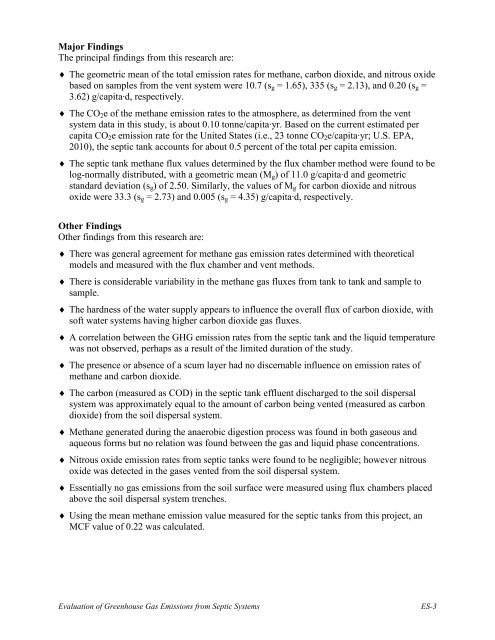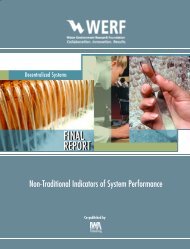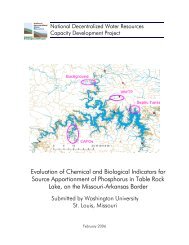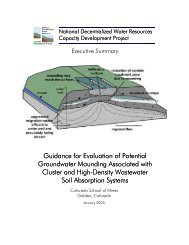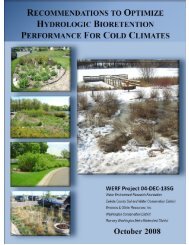Evaluation of Greenhouse Gas Emissions from Septic ... - Geoflow
Evaluation of Greenhouse Gas Emissions from Septic ... - Geoflow
Evaluation of Greenhouse Gas Emissions from Septic ... - Geoflow
Create successful ePaper yourself
Turn your PDF publications into a flip-book with our unique Google optimized e-Paper software.
Major FindingsThe principal findings <strong>from</strong> this research are:♦ The geometric mean <strong>of</strong> the total emission rates for methane, carbon dioxide, and nitrous oxidebased on samples <strong>from</strong> the vent system were 10.7 (s g = 1.65), 335 (s g = 2.13), and 0.20 (s g =3.62) g/capita·d, respectively.♦ The CO 2 e <strong>of</strong> the methane emission rates to the atmosphere, as determined <strong>from</strong> the ventsystem data in this study, is about 0.10 tonne/capita·yr. Based on the current estimated percapita CO 2 e emission rate for the United States (i.e., 23 tonne CO 2 e/capita·yr; U.S. EPA,2010), the septic tank accounts for about 0.5 percent <strong>of</strong> the total per capita emission.♦ The septic tank methane flux values determined by the flux chamber method were found to belog-normally distributed, with a geometric mean (M g ) <strong>of</strong> 11.0 g/capita·d and geometricstandard deviation (s g ) <strong>of</strong> 2.50. Similarly, the values <strong>of</strong> M g for carbon dioxide and nitrousoxide were 33.3 (s g = 2.73) and 0.005 (s g = 4.35) g/capita·d, respectively.Other FindingsOther findings <strong>from</strong> this research are:♦ There was general agreement for methane gas emission rates determined with theoreticalmodels and measured with the flux chamber and vent methods.♦ There is considerable variability in the methane gas fluxes <strong>from</strong> tank to tank and sample tosample.♦ The hardness <strong>of</strong> the water supply appears to influence the overall flux <strong>of</strong> carbon dioxide, withs<strong>of</strong>t water systems having higher carbon dioxide gas fluxes.♦ A correlation between the GHG emission rates <strong>from</strong> the septic tank and the liquid temperaturewas not observed, perhaps as a result <strong>of</strong> the limited duration <strong>of</strong> the study.♦ The presence or absence <strong>of</strong> a scum layer had no discernable influence on emission rates <strong>of</strong>methane and carbon dioxide.♦ The carbon (measured as COD) in the septic tank effluent discharged to the soil dispersalsystem was approximately equal to the amount <strong>of</strong> carbon being vented (measured as carbondioxide) <strong>from</strong> the soil dispersal system.♦ Methane generated during the anaerobic digestion process was found in both gaseous andaqueous forms but no relation was found between the gas and liquid phase concentrations.♦ Nitrous oxide emission rates <strong>from</strong> septic tanks were found to be negligible; however nitrousoxide was detected in the gases vented <strong>from</strong> the soil dispersal system.♦ Essentially no gas emissions <strong>from</strong> the soil surface were measured using flux chambers placedabove the soil dispersal system trenches.♦ Using the mean methane emission value measured for the septic tanks <strong>from</strong> this project, anMCF value <strong>of</strong> 0.22 was calculated.<strong>Evaluation</strong> <strong>of</strong> <strong>Greenhouse</strong> <strong>Gas</strong> <strong>Emissions</strong> <strong>from</strong> <strong>Septic</strong> SystemsES-3


